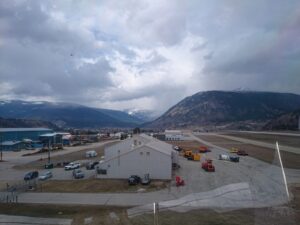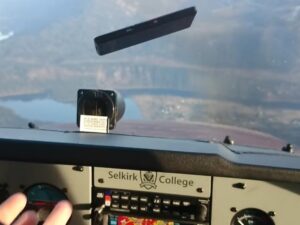Today I completed the last flight of my first year at Selkirk College. This flight wasn’t anything too out of the ordinary, but it did have some things that I had never tried before, more specifically, something that I had not experienced under the hood before. It was only a week ago or so that I had rediscovered how thrilling spins were. On this flight, I found out how different it feels to be in a spin while not seeing out the windows. When recovering from a spin, your first reaction is to pull the throttle out to idle and neutralize the aileron. Immediately after that, push full deflection of the rudder in the opposite direction of the spin and follow it up with a forward push on the control column to break the stall. Once the spin stops (which usually happens pretty quickly), recover by pitching up and applying full power, attempting to regain and stabilize your altitude, followed by airspeed. When under the hood, the steps are the same; the only difference is that you can’t rely upon most of the aircraft’s instruments.
Pull, kick, push, and recover.
Ray Preston: Abbreviated spin recovery
The aircraft we use are outfitted with the usual analog instruments along with an Aspen PFD and Garmin GPS unit. Even though these aircraft have some very nice digital instruments, they still get confused when in a spin. The attitude indicator can topple, the compass and heading indicator are useless too, and even the Aspen displays a message asking to crosscheck attitude – the Aspen is pretty much saying it’s futile at this point. The only reliable instrument, in this case, is the turn coordinator because it has a pinned axis which means it can’t topple. To figure out which way the aircraft is spinning, all that needs to be done is to glance at the turn coordinator; the banked wings will show the direction quite simply. Once the spin has been subdued, the use of the wings will then indicate if you’re close to being level or not.
I think this was the first time I felt different than what the instruments were telling me – or maybe I subconsciously believed an error from one. After recovery, the Aspen tends to indicate that the aircraft is still banked by quite a bit even though there isn’t any error message being displayed. On the other hand, the turn coordinator shows that you are, in fact, closer to being level than what the Aspen will tend to make you believe. Ignoring your basic senses of motion and accepting the information from an instrument is an exciting feeling. You have to consciously tell yourself what you feel is wrong and that you must pay particularly close attention to making sure you aren’t subconsciously ‘correcting’ due to this false sensation.
With the closing of my first year, I am already very excited for the start of next year. In addition to this, I’m also quite excited for this summer – I’ll be training to earn both a night and float rating; so many experiences to be had!




